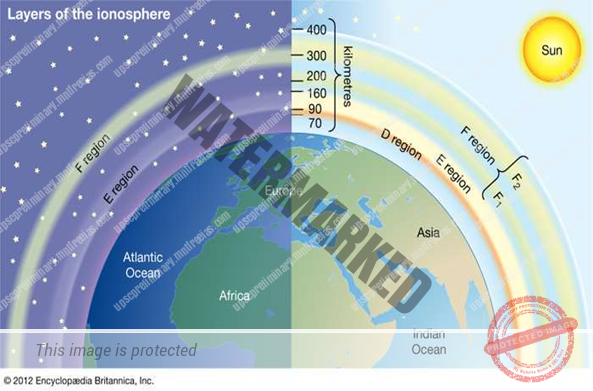- THE MESOSPHERE
- AIRGLOW
- THE IONOSPHERE
- LAYERS OF THE IONOSPHERE
UNIT 4 – CLIMATOLOGY – PART 5
THE MESOSPHERE
Mesosphere, region of the upper atmosphere between about 50 and 80 km (30 and 50 miles) above the surface of the Earth. The base of the mesosphere is defined as the temperature maximum existing at the top of the stratosphere, with the boundary between the two regions usually called the stratopause. The mesosphere extends upward to the next temperature minimum, which defines the base of the thermosphere; the boundary between the two regions is called the mesopause.
The percentage of oxygen, nitrogen, and carbon dioxide in the air in the mesosphere is essentially the same as that in the levels of the Earth’s atmosphere immediately above the Earth’s surface. The principal differences are that the density of the air is much less, there is very little water vapour in the mesosphere, and the mesosphere contains higher percentages of ozone than the lower levels.
AIRGLOW
Faint luminescence of Earth’s upper atmosphere that is caused by Air molecules’ and atoms’ selective absorption of solar ultraviolet and X-radiation. Most of the airglow emanates from the region about 50 to 300 km (31 to 180 miles) above the surface of Earth, with the brightest area concentrated at altitudes around 97 km (60 miles). Unlike the aurora, airglow does not exhibit structures such as arcs and is emitted from the entire sky at all latitudes at all times. The nocturnal phenomenon is called nightglow. Dayglow and twilight glow are analogous terms.
THE IONOSPHERE
Discovery of the ionosphere extended over nearly a century. As early as 1839, The German Mathematician Carl Friedrich Gauss speculated that an electrically conducting region of the atmosphere could account for observed variations of Earth’s magnetic field.
The notion of a conducting region was reinvoked by others, notably in 1902 by the American engineer Arthur E. Kennelly and the English physicist Oliver Heaviside, to explain the transmission of radio signals around the curve of Earth’s surface before definitive evidence was obtained in 1925. For some years the ion-rich region was referred to as the Kennelly-Heaviside layer.
The name “ionosphere” was introduced first in the 1920s and was formally defined in 1950 by a committee of the Institute of Radio Engineers as “the part of the earth’s upper atmosphere where ions and electrons are present in quantities sufficient to affect the propagation of radio waves.” Much of the early research on the ionosphere was carried out by radio engineers and was stimulated by the need to define the factors influencing long-range radio communication.
Subsequent research has focused on understanding the ionosphere as the environment for Earth-orbiting satellites and, in the military arena, for ballistic missile flight. Scientific knowledge of the ionosphere has grown tremendously, fueled by a steady stream of data from spacecraft-borne instruments and enhanced by measurements of relevant atomic and molecular processes in the laboratory.
LAYERS OF THE IONOSPHERE
Historically, the ionosphere was thought to be composed of a number of relatively distinct layers that were identified by the letters D, E, and F. The F layer was subsequently divided into regions F1 and F2. It is now known that all these layers are not particularly distinct, but the original naming scheme persists.
It appears that Edward V. Appleton, a pioneer in early radio probing of the ionosphere, is responsible for the nomenclature. Appleton was accustomed to using the symbol E to describe the electric field of the wave reflected from the first layer of the ionosphere that he studied. Later he identified a second layer at higher altitude and used the symbol F for the reflected wave.
Suspecting a layer at lower altitude, he adopted the additional symbol D. In time, the letters came to be associated with the layers themselves rather than with the field of the reflected waves.
It is now known that electron density increases more or less uniformly with altitude from the D region, reaching a maximum in the F2 region. Though the nomenclature used to describe the different layers of the ionosphere continues in wide use, the definitions have evolved to reflect the improved understanding of the underlying physics and chemistry.

